Solved Examples and Worksheet for Interpreting Scatter Plots
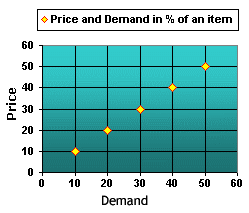
A. Negative trend
B. No trend
C. Positive trend
Step: 1
From the graph, as the demand of an item rises, there is a rise in the price of the item and as the demand reduces there is a decrease in the price of an item.
Step: 2
If one set of data tends to increase with an increase in the other set, the plot is said to have a positive trend.
Step: 3
So, the scatter plot shows a positive trend.
Correct Answer is : Positive trend
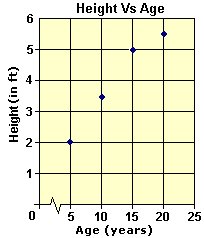
A. 4 ft
B. 5.6 ft
C. 3.5 ft
D. 5 ft
Step: 1
The vertical coordinate of each point in the scatterplot represents Andrew's height and the horizontal coordinate represents his age.
Step: 2
From the graph, the vertical coordinate of the point corresponding to 15 years is 5 ft.
Step: 3
So, Andrew was 5 ft tall when he was 15 years old.
Correct Answer is : 5 ft

A. 157.5 km
B. 55 km
C. 52.5 km
D. 160 km
Step: 1
The vertical coordinate of each point on the scatter plot indicates the distance traveled by Diane during each hour.
Step: 2
The distance traveled in the first hour of the journey is 50 km.
Step: 3
The distance traveled in the second hour is 55 km.
Step: 4
The distance covered in third hour is 52.5 km. as it is in between 50 and 55.
Step: 5
The total distance covered in the first three hours of the journey = 50 + 55 + 52.5 = 157.5 km.
[Add.]
Step: 6
The distance traveled by Diane in 3 hours is 157.5 km.
Correct Answer is : 157.5 km
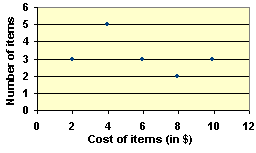
A. $50
B. $90
C. $80
D. $100
Step: 1
The height of each point on the scatter plot indicates the number of items of a particular cost bought by Lindsay.
Step: 2
From the graph, the number of items of costs $2, $4, $6, $8 and $10 are 3, 5, 3, 2 and 3 respectively.
Step: 3
The total amount spent by her is the sum of the products of the number of items and the cost of each item.
Step: 4
So, the total amount = $2 x 3 + $4 x 5 + $6 x 3 + $8 x 2 + $10 x 3
= 6 + 20 + 18 + 16 + 30 = $90
[Multiply number of items and cost of each item and add all.]
Step: 5
So, Lindsay spent $90 in the supermarket.
Correct Answer is : $90
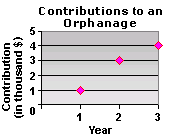
A. $1,000
B. $3,000
C. $2,000
D. $4000
Step: 1
The height of each point in the plot represents the contribution made in that particular year.
Step: 2
The height of the point corresponding to the 1st year represents the value $1000, which is the least.
Step: 3
So, the minimum contribution made to the orphanage was $1,000.
Correct Answer is : $1,000

A. 65
B. 40
C. 35
D. 90
Step: 1
The height of each point in the scatter plot gives the distance traveled by Victor at the particular speed in the time.
Step: 2
From the graph, Victor can travel 150 miles in the time if he travels at 70 mph.
Step: 3
Victor can travel 190 miles in the time if he travels at 80 mph.
Step: 4
Difference between the distances = 190 - 150 = 40
[Subtract 150 from 190.]
Step: 5
So, Victor can travel 40 more miles in the time if he travels at 80 mph than that when he travels at 70 mph.
Correct Answer is : 40
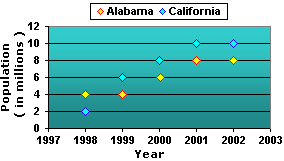
A. 200%
B. 100%
C. 50%
D. 150%
Step: 1
The height of each point in the plot represents the population of a particular state in a particular year.
Step: 2
From the plot, the population of Alabama in the year 1999 is 4 million.
Step: 3
The population of Alabama in the year 2002 is 8 million.
Step: 4
Increase in the population = 8 - 4 = 4 million
[Subtract 4 from 8.]
Step: 5
So, the percentage increase in the population = Increase Original
= 4 4
[Divide.]
Correct Answer is : 100%
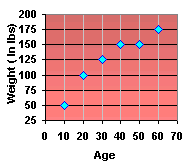
A. 100
B. 125
C. 50
D. 175
Step: 1
In the scatter plot, the horizontal axis represents Charles's age and the vertical axis represents his weight in lb.
Step: 2
The vertical distance of each point in the scatter plot indicates the weight of Charles when he was a particular age.
Step: 3
From the graph, the vertical distance of the point corresponding to 30 is 125.
Step: 4
So, the weight of Charles was 125 lb when he was 30 years old.
Correct Answer is : 125
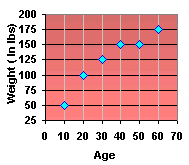
A. 10
B. 60
C. 20
D. 30
Step: 1
In the scatter plot, the horizontal axis represents Jeff's age and the vertical axis represents his weight in lb.
Step: 2
The vertical distance of each point in the scatter plot indicates the weight of Jeff when he was a particular age.
Step: 3
From the graph, the vertical distance of the point corresponding to 20 is 100.
Step: 4
So, Jeff's weight was 100 lb. when he was 20 years old.
Correct Answer is : 20
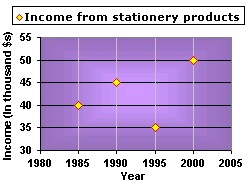
A. 2000
B. 1995
C. 1990
D. 1985
Step: 1
The height of each point in the graph indicates the income (in $1000) of the dealer in the corresponding year.
Step: 2
From the graph, the incomes of the dealer in 1985, 1990, 1995 and 2000 are $40000, $45000, $35000 and $50000, respectively.
Step: 3
The income of the dealer was the highest in 2000.
Correct Answer is : 2000
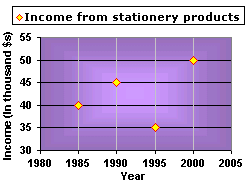
A. $35 thousands
B. $40 thousands
C. $45 thousands
D. $50 thousands
Step: 1
In the scatter plot, the horizontal axis indicates the year and the vertical axis indicates the income (in $1000) earned by the wholesale dealer.
Step: 2
The height of each point in the graph indicates the income (in $1000) of the dealer in the particular year.
Step: 3
From the graph, the vertical coordinate of the point corresponding to the year 2000 is 50.
Step: 4
So, the income of the wholesale dealer in 2000 was $50,000.
Correct Answer is : $50 thousands
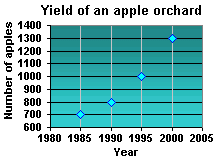
A. 300
B. 50
C. 200
D. 100
Step: 1
The height of each point in the scatter plot indicates the yield of the apple orchard in the corresponding year.
Step: 2
From the scatter plot, the number of apples in the year 1985 = 700
Step: 3
Number of apples in the year 1990 = 800
Step: 4
Increase in the number of apples
= 800 - 700 = 100
[Subtract.]
Correct Answer is : 100
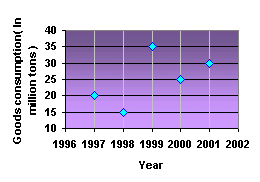
A. 5 : 7
B. 2 : 3
C. 1 : 1
D. 7 : 5
Step: 1
The vertical coordinate of each point on the scatter plot indicates the consumption of goods (in million tons) in the corresponding year.
Step: 2
From the plot, the consumption of the goods in 1999 was 35 million tons.
Step: 3
The consumption of the goods in the year 2000 is 25 million tons.
Step: 4
So, the ratio of the consumption of goods in 1999 to that in 2000 = 35 : 25 = 7 : 5
Correct Answer is : 7 : 5
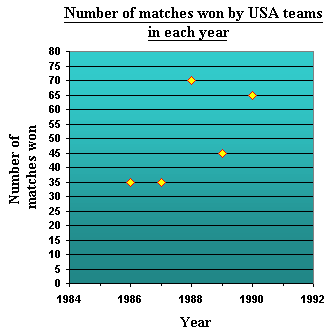
A. 100
B. 180
C. 250
D. 115
Step: 1
Number of matches won in 1988 = 70
Step: 2
Number of matches won in 1989 = 45
Step: 3
Number of matches won in 1990 = 65
Step: 4
Total number of matches won by USA from 1988 to 1990 = 70 + 45 + 65 = 180
Step: 5
So, the total number of matches won by USA from 1988 to 1990 is 180.
Correct Answer is : 180
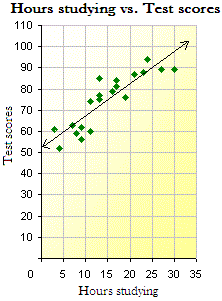
A. 65
B. 70
C. 72
D. 68
E. 60
Step: 1
Each point in the scatter plot shows the test score of a student who studied for the respective number of hours.
Step: 2
Draw a vertical line starting from 10 hours in the scatter plot. This line intersects the trend line at a point.
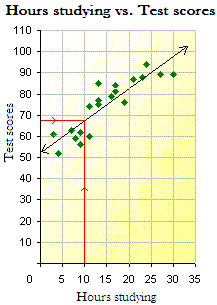

Step: 3
From the intersection, draw a horizontal line that intersects the y-axis. This intersection point on the y-axis gives the required test score as the y-axis represents the test scores.
Step: 4
So, a student who studied for 10 hours would have scored about 68 points
Correct Answer is : 68
- Finding Intercepts of Linear Relations-Gr 8-Solved Examples
- Slope of a Line from its Graph-Gr 8-Solved Examples
- Constructing Scatter Plots-Gr 8-Solved Examples
- Scatter Plots Line of Best Fit and its Correlations-Gr 8-Solved Examples
Related Worksheet
- Data